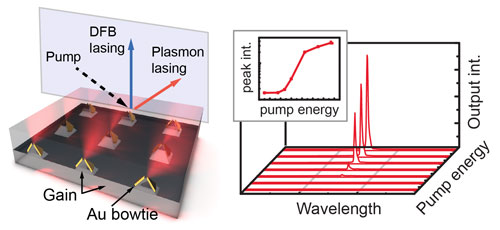| Posted: Oct 04, 2012 | |
Researchers fabricate a virus-sized laser |
|
| (Nanowerk Spotlight) Reducing the size of photonic and electronic elements is critical for ultra-fast data processing and ultra-dense information storage. The miniaturization of a key, workhorse optical instrument – the laser – is no exception. Coherent light sources at the nanometer scale are important not only for exploring phenomena in small dimensions but also for realizing optical devices with sizes that can beat the diffraction limit of light. | |
| Researchers at Northwestern University have now found a way to manufacture single laser devices that are the size of a virus particle and that operate at room temperature. They show that subdiffraction nanoresonators based on metallic bowties, when coupled to a gain material, can generate coherent and directional light emission. | |
| "The reason that we can fabricate nano-lasers with sizes smaller than that allowed by diffraction is because we made the lasing cavity out of metal nanoparticle dimers—structures with a 3D 'bowtie' shape," Teri W. Odom, Board of Lady Managers of the Columbian Exposition Professor of Chemistry and Professor of Materials Science and Engineering at Northwestern University, tells Nanowerk. "These metal nanostructures – nanoparticle dimers with a gap size of tens of nanometers – support localized surface plasmons, collective oscillations of electrons, which have no fundamental size limits when it comes to confining light." | |
| As Odom and her team report in the September 26, 2012 online edition of Nano Letters ("Plasmonic Bowtie Nanolaser Arrays"), the use of the bowtie geometry has two significant benefits over previous work on plasmon lasers: 1) the bowtie structure provides a well-defined, electromagnetic hot spot in a nano-sized volume because of an antenna effect; and 2) the individual structure has only minimal metal “losses” because of its discrete geometry. | |
 |
|
| Left: 3D gold bow-tie resonators in array supported by organic dye materials. Right: Lasing spectra, representing the onset and growth of amplified stimulated emission above a certain threshold level. (Image: Dr. Odom, Northwestern University) | |
| "Surprisingly" says Odom, "we also found that when arranged in an array, the 3D bowtie resonators could emit light at specific angles according to the lattice parameters." | |
| She explains that these bowtie resonators are an ideal system to localize and enhance electric fields within nanoscale volumes. "The primary advantage of a bowtie geometry over a symmetric, single nanoparticle as an optical resonator is their high Purcell factor. With an increased Purcell factor because of a reduced mode volume, the threshold condition to initiate lasing in bowtie nanoparticles can be readily satisfied, even at ambient temperatures." | |
| In their experiments, the team shows that plasmonic lasing can occur at room temperature near localized surface plasmon resonance wavelengths when strong electric field localizations are present in the gap. | |
| Odom also points out that this bowtie design is highly defect-tolerant, which is important for practical and scalable applications. | |
| "Ultimately" she says, "the 3D resonator design can be interfaced with other gain materials, such as highly oriented molecules or single quantum dots, to improve the coupling efficiency for designing low-threshold nanolasers or new platforms for studying quantum plasmon effects." | |
 By
Michael
Berger
– Michael is author of three books by the Royal Society of Chemistry:
Nano-Society: Pushing the Boundaries of Technology,
Nanotechnology: The Future is Tiny, and
Nanoengineering: The Skills and Tools Making Technology Invisible
Copyright ©
Nanowerk LLC
By
Michael
Berger
– Michael is author of three books by the Royal Society of Chemistry:
Nano-Society: Pushing the Boundaries of Technology,
Nanotechnology: The Future is Tiny, and
Nanoengineering: The Skills and Tools Making Technology Invisible
Copyright ©
Nanowerk LLC
|
|
|
Become a Spotlight guest author! Join our large and growing group of guest contributors. Have you just published a scientific paper or have other exciting developments to share with the nanotechnology community? Here is how to publish on nanowerk.com. |
|
